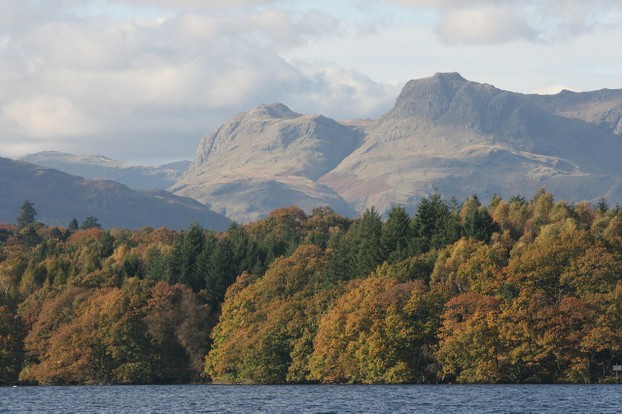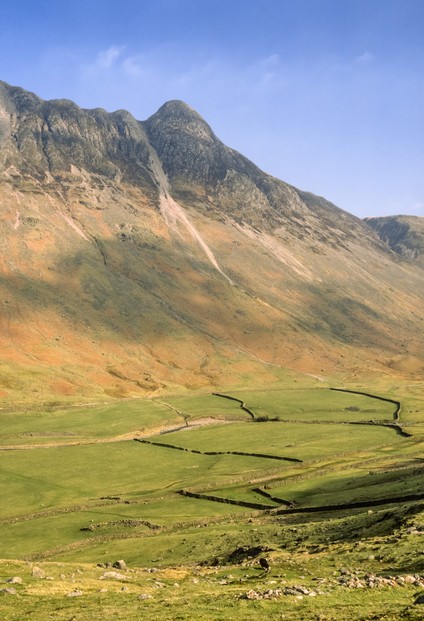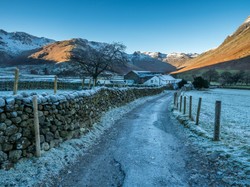With the first sections of your 25 mile route behind you you will soon by seeking refeshment, and near to the end of Mickleden is the Old Dungeon Ghyll Hotel. There has been a drovers inn on this site for centuries,but it has been rebuilt over the years, but it is old and replete in character, with a large range wood burning fireplace and hand pumped ales. It is a place where climbers who have tried the steep crags above, such as Middlefell Buttress come to rest and refuel. But centuries ago the place rang with the shouts of men and the bellowing of bullocks meant for the meat markets.
The route to Ambleside runs down the valley. You pass another hostelry, the New Dungeon Ghyll, next to which is the Stickle Barn, named after the mountain lake Stickle Tarn two thousand or so feet above it. This converted stone barn is one of my favourite places to refresh myself, and after our much loved walks to Stickle Tarn Maureen and I stop at the barn for drinks, which for us is an essential ritual.
The valley is a place of beautifully kept green fields, whose loose cropped turf reveals their use as sheep pasture. It makes a pleasant downhill walk, sometimes along the river that flows down to the lake below. At times through fields and at other times through patches of woodland,it is a joyful journey through a now peaceful land.
Further down the valley you pass Elterwater, whose name comes from elter, old Norse for swan.so swan lake, though I have never seen swans there. There are more hostelries and cafes in Elterwater and the villages of Langdale and Chapel Stile , through which you pass later on.
You see how the place names that I have mentioned reveal the complex ethnic history of the area. Norse, English and Cumbric, a dialect of Welsh all have left their traces in the place names. Farmers in Cumbria used to count their sheep in Cumbric until a century or less ago, yan,tan tethera [one, two, three... and so on]
By now you are well on your route to Ambleside, which is situated on Lake Windermere and is well blessed with hotels. We are staying there this summer while Maureen does the route as a sponsored walk for a cancer charity. I have done it already and have to work that weekend, it is examination marking time and I am under strict pressure to meet deadlines, so while she walks, I work, with my computer in the hotel room. I will find some time to enjoy the town and the lake









 Women of the Gospelson 10/11/2025
Women of the Gospelson 10/11/2025
 Religious Gardenson 08/25/2025
Religious Gardenson 08/25/2025
 Doctor of the Church: John Henry Newmanon 08/03/2025
Doctor of the Church: John Henry Newmanon 08/03/2025
 Restoring the Palm Houseon 07/16/2025
Restoring the Palm Houseon 07/16/2025



Comments
There may be records somewhere, but I have no access to them. In the highlands men received their allocation of land in return for military service to the clan chief. Money did not change hands in the non cash economy of the highlands at the time.
Thank you for your comment below, in answer to my previous observation and question.
Individual clan members renting clan chief-propertied lands intrigues me.
Is it known what amounts and mediums such rent involved?
British law regarded the clan or tribal lands as the property of the clan chief and not collectively owned. Individual clan members rented lands from the chief and could be expelled.
I have Armstrong blood. My great grandmother was Sarah Armstrong the daughter of a Scots soldier. But she did not dwell in the Armstrong lands, for she went with her family when her father was posted to India.
Thank you for your comment below, on Apr 14, 2023, in answer to my previous, previous-day observation and question on Apr 13, 2023.
Your answer, immediately below, that "I am unsure, but there are still Armstrongs in the traditional clan territory, but they do not own it" intrigues me."
Is the ownership because of the original expulsion to Northern Ireland invoking a forever-withheld right of Armstrong descendants to install themselves again as clan-territory owners?
I am unsure, but there are still Armstrongs in the traditional clan territory, but they do not own it.
It is too far back for me to know what previous surnames my Armstrong ancestors had.
Genealogical and semi-genealogical sources online equate the last name Armstrong with a nickname -- arm strong -- that evolved into a surname.
If the above be true, is it known what family names the strong arms had before they made themselves known as Armstrong? For example, is it known in your family lines what surnames your Armstrong ancestors previously had?
I don't think that the lands were confiscated, though Armstrongs may have been among the Scots forcibly moved to Northern Ireland by King James.
The last paragraph under your first subheading, The Beginning of the Walk, considers the fate of a male Armstrong and his sons.
What would have happened to the female Armstrongs and the Armstrong properties? Would everyone and everything Armstrong have been proscribed, like the MacGregor clan?
That's impressive. :)